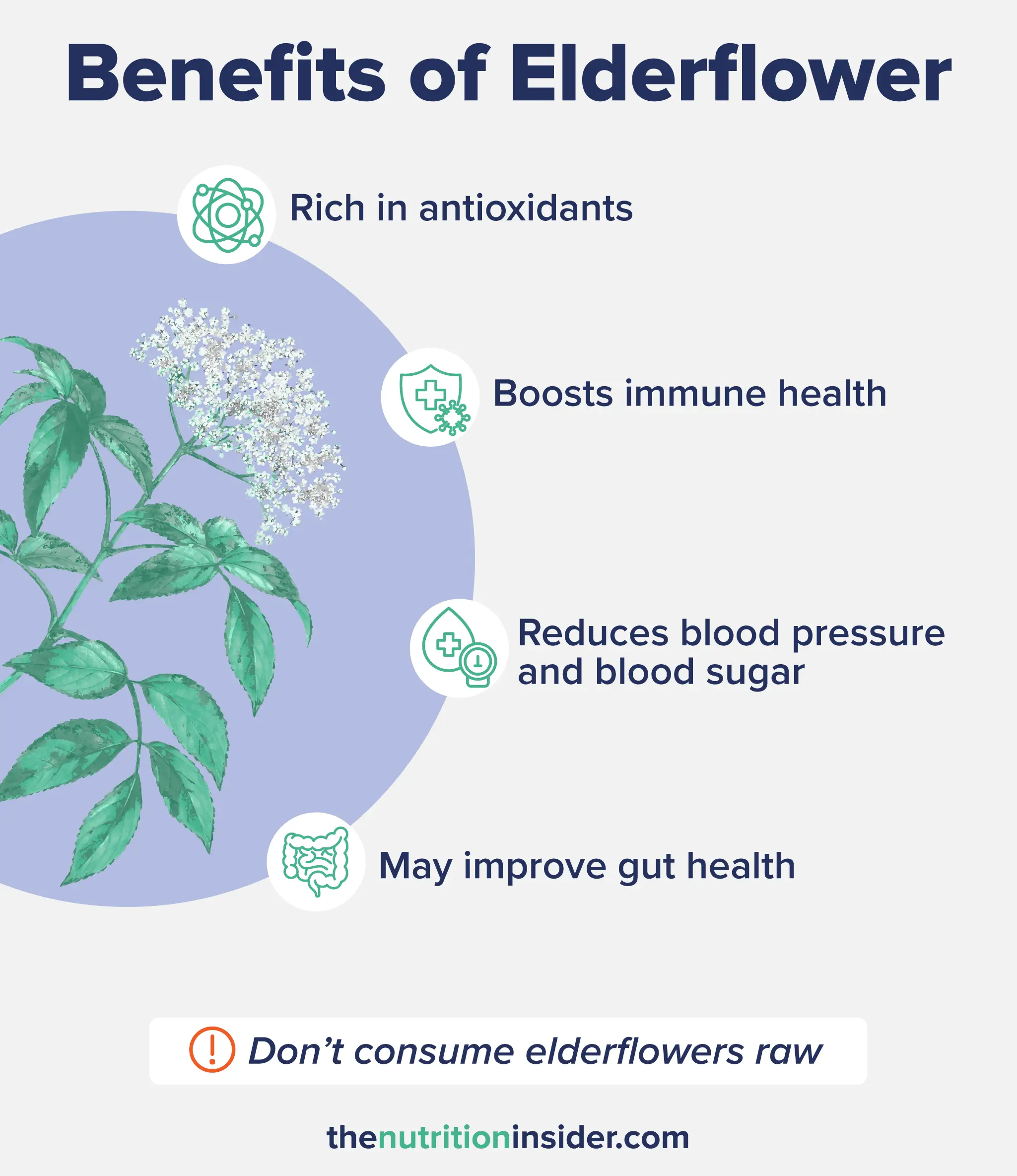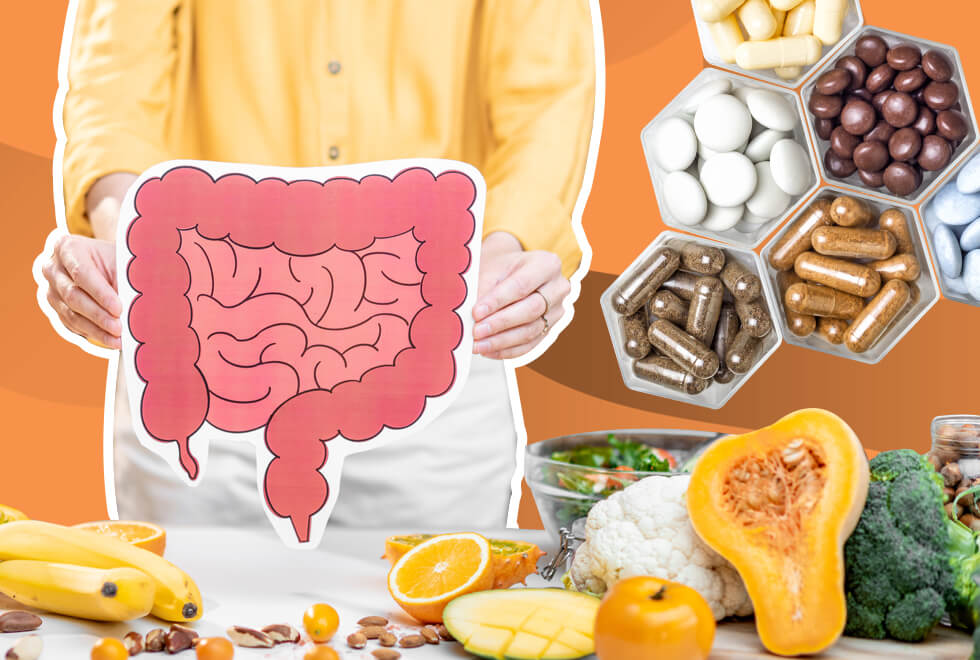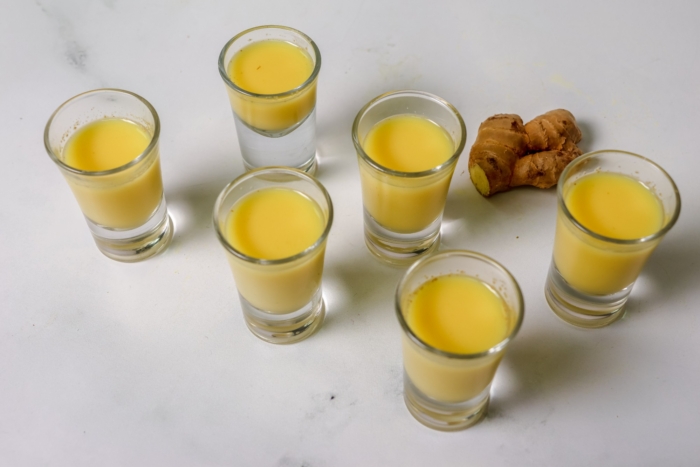This post contains links through which we may earn a small commission should you make a purchase from a brand. This in no way affects our ability to objectively critique the products and brands we review.
What Is Elderflower?
Evidence Based Research To fulfill our commitment to bringing our audience accurate and insightful content, our expert writers and medical reviewers rely on carefully curated research.
Read Our Editorial Policy
Elderflowers are white flowers that bloom on the black elder tree, a plant with a long and rich history of use in herbal medicine, folklore, and mythology.
In centuries past, black elder trees (Sambucus nigra) have been seen as sacred and protective plants, with stories and legends placing them with deities, dryads, and Celtic druids. Modern-day culture also explores the mysticality of the black elder, as seen with the elder wand of Harry Potter and the Deathly Hallows.
Now, we have the research to back up these folkloric claims (well, not the magical part), finding that components of the elder tree (namely elderflower and elderberry) have many health-protective properties, including for immune, cardiovascular, and gut health.
In this article, we’ll explore the research behind these benefits, how best to consume elderflower and the differences between elderflower and elderberry.
Elderflower Vs. Elderberry
Elderflower and elderberry both come from the elder tree—elderflower is the flower of the plant, while elderberries are the (you guessed it) berries.
Elderflower blossoms appear in the spring and early summer, turning into the purplish-blue elderberries that ripen in late summer to early fall.
The aromatic blossoms of the elderflower are more commonly used in teas, cordials, and liquors. Conversely, elderberry is most often seen in jams, syrups, and immune health supplements.
As a quick aside, elderflowers and elderberries need to be cooked before eating. Despite their similarity in appearance to blueberries or grapes, you can’t eat raw elderberries right off the plant, as they contain a mildly toxic substance that can cause nausea, vomiting, and diarrhea that cooking removes.
As expected from the parts of the tree they come from, elderberry has a tart and fruity taste, and elderflowers are light and floral.Both elderflower and elderberry have the same scientific name of Sambucus nigra (as the former turns into the latter), but elderberries are more often studied in clinical research.
Benefits of Elderflower
Elderflower and elderberry have a wide array of health benefits, mostly stemming from the quantity of bioactive compounds that provide antioxidant, anti-inflammatory, and antimicrobial activity.

1. Rich in Antioxidants
Both elderflower and elderberry contain vast amounts of antioxidants called phenolic compounds and flavonoids.
Antioxidants are necessary to neutralize free radicals—harmful compounds that accumulate with age, disease, or unhealthy lifestyles. They also help to fight chronic inflammation by reducing the activity of pro-inflammatory cytokines.1
One study looked specifically at elderflower extract and found that it contained 46 bioactive compounds. The main phenolic compounds found were derived from quercetin, chlorogenic acid, and naringenin.2
Quercetin is found in apples and onions and is known for supporting immune and cardiovascular health; chlorogenic acid is a compound also in coffee that reduces inflammation; and naringenin is a flavonoid antioxidant in oranges and citrus that has antibacterial and anti-cancer properties.3
Elderberries also have antioxidants called anthocyanins and proanthocyanins—the same type found in blueberries, blackberries, and other dark berries.4
2. Immune Health
Because of their antioxidant, antimicrobial, and anti-inflammatory properties, elderflower and elderberry are well-suited for supporting immune health.
Elderberry is the part of the elder tree that is most associated with immune system functioning, as it’s often seen in gummies or supplements with zinc and vitamin C during cold and flu season. Therefore, it’s also the form found in research regarding immune health.
In a study of 312 people taking an overseas flight, those who were randomly assigned to take elderberry extract ten days beforehand had significantly shorter cold durations and lower symptom scores compared to those who got sick in the placebo group.5
Another systematic review of five randomized controlled trials found that elderberry may reduce the risk and severity of cold or flu symptoms or duration but does not reduce the risk of developing them in the first place.6
3. Reduces Blood Pressure and Blood Sugar
Components of the elder tree may benefit some aspects of cardiovascular health, including lowering blood pressure and blood sugar.
The flavonoid and phenolic compounds found in elderflower and elderberry (like quercetin and anthocyanins) may benefit blood pressure because they support vascular health and blood flow.7
In a study with animals, rats with hypertension that received elderberry extract saw significant reductions in both systolic and diastolic blood pressure.8
Research suggests that elderflower can also decrease blood sugar levels, as it exhibits insulin-like properties. A lab-based study found that an elderflower extract increased glucose uptake into cells, which would correlate to lower blood sugar levels.9
4. Gut Health
Elderflower may be helpful for improving aspects of the digestive system, including reducing chronic constipation and improving gut microbial species.
In a 9-week longitudinal study called ELDERGUT, adults who took a purified extract from European black elderberries had profound changes to their gut microbial diversity. One specific microbe called Akkermansia spp. continued to increase in some people even after the supplementation ended.10
A higher abundance of Akkermansia in the microbiome is associated with better gut health, reduced risk of inflammatory bowel disease, improved immune system functioning, and reduced risk of obesity.11
5. May Inhibit Cancer Cell Growth
Lastly, the bioactive compounds in elderflower and elderberry have been shown to inhibit cancer cell growth in cell-based studies in the lab.
One cell-based study looked at how elderflower extracts impacted bladder carcinoma cells and normal human fibroblast cells. The researchers found that elderflower exhibited cytotoxic (cell-killing) activity only on the bladder carcinoma cells and not the healthy cells, indicating selectivity for killing cancer cells.12
Another review study concluded that Sambucus nigra (both flowers and berries) prevents mutations that increase the risk of cancer development, inhibits cancer cell growth, induces apoptosis (programmed cell death), and inhibits the growth of malignant tumors and metastasis.1
However, studies with humans have not yet been conducted to verify these results, so more evidence is needed.
How to Consume Elderflower: Dose and Precautions
There are many ways to consume elderflower, including:
- Elderflower tea
- Elderflower cordial
- Elderflower liquor
- Elderflower syrup
- Elderflower extracts or tinctures (commonly found in herbal remedies)
It’s important to know that you cannot consume elderflowers or elderberries raw (especially the berries) because they contain a toxic compound that cooking removes.
Elderflower is not often seen in supplements, so dosages are not widely known. If you have a cold or illness, drinking elderflower tea two to three times per day may help, but there is no research on dosages.
However, elderberry is more studied in supplemental form. Dosages recommended by popular elderberry products range from 650mg to 1500mg per day.
Elderflower or elderberry is generally recognized as safe, but excessive amounts may cause digestive problems like nausea or diarrhea.
Elderflower Benefits FAQs
What does elderflower taste like?
Unsurprisingly, elderflower has a floral flavor, but it’s light and not overpowering. Elderflower tea is described as having natural sweetness with notes of honey, vanilla, and tropical fruits. Some say elderflower has savory notes, as well.
Are elderflower and elderberry the same thing?
Elderflower and elderberry come from the same plant (the black elder or Sambucas nigra). The former is the white flowers of the elder tree, which develop into the deep purplish-blue elderberries later in the year. They have similar benefits and antioxidant profiles, but elderberry is much more well-studied than elderflower.
How does elderflower make you feel?
Elderflower on its own likely does not make you feel like anything. However, if you consume it as a herbal tea, you may feel calm and relaxed simply from the act of drinking a warm beverage.
Who should not take elderflower?
As there is not enough clinical data, pregnant and breastfeeding people should avoid using elderflower or elderberry. As elderberry may lower blood pressure, people taking blood pressure medications should use caution or speak with their healthcare provider first. Similarly, people taking diabetes medications should monitor their blood sugar levels carefully if they use elderflower, as it may lower blood sugar too much.
- Stępień, A. E., Trojniak, J., & Tabarkiewicz, J. (2023). Health-Promoting Properties: Anti-Inflammatory and Anticancer Properties of Sambucus nigra L. Flowers and Fruits. Molecules (Basel, Switzerland), 28(17), 6235. https://doi.org/10.3390/molecules28176235
- Ferreira-Santos, P., Badim, H., Salvador, Â. C., Silvestre, A. J. D., Santos, S. A. O., Rocha, S. M., Sousa, A. M., Pereira, M. O., Wilson, C. P., Rocha, C. M. R., Teixeira, J. A., & Botelho, C. M. (2021). Chemical Characterization of Sambucus nigra L. Flowers Aqueous Extract and Its Biological Implications. Biomolecules, 11(8), 1222. https://doi.org/10.3390/biom11081222
- Aghababaei, F., & Hadidi, M. (2023). Recent Advances in Potential Health Benefits of Quercetin. Pharmaceuticals (Basel, Switzerland), 16(7), 1020. https://doi.org/10.3390/ph16071020
- Ho, G. T., Wangensteen, H., & Barsett, H. (2017). Elderberry and Elderflower Plant Extract, Phenolic Compounds, and Metabolites and Their Effect on Complement, RAW 264.7 Macrophages and Dendritic Cells. International journal of molecular sciences, 18(3), 584. https://doi.org/10.3390/ijms18030584
- Tiralongo, E., Wee, S. S., & Lea, R. A. (2016). Elderberry Supplementation Reduces Cold Duration and Symptoms in Air-Travellers: A Randomized, Double-Blind Placebo-Controlled Clinical Trial. Nutrients, 8(4), 182. https://doi.org/10.3390/nu8040182
- Wieland, L. S., Piechotta, V., Feinberg, T., Ludeman, E., Hutton, B., Kanji, S., Seely, D., & Garritty, C. (2021). Elderberry for prevention and treatment of viral respiratory illnesses: a systematic review. BMC complementary medicine and therapies, 21(1), 112. https://doi.org/10.1186/s12906-021-03283-5
- Amponsah-Offeh, M., Diaba-Nuhoho, P., Speier, S., & Morawietz, H. (2023). Oxidative Stress, Antioxidants and Hypertension. Antioxidants (Basel, Switzerland), 12(2), 281. https://doi.org/10.3390/antiox12020281
- Ciocoiu, M., Badescu, M., Badulescu, O., & Badescu, L. (2016). The beneficial effects on blood pressure, dyslipidemia and oxidative stress of Sambucus nigra extract associated with renin inhibitors. Pharmaceutical biology, 54(12), 3063–3067. https://doi.org/10.1080/13880209.2016.1207088
- Ho, G. T., Kase, E. T., Wangensteen, H., & Barsett, H. (2017). Effect of Phenolic Compounds from Elderflowers on Glucose- and Fatty Acid Uptake in Human Myotubes and HepG2-Cells. Molecules (Basel, Switzerland), 22(1), 90. https://doi.org/10.3390/molecules22010090
- Reider, S., Watschinger, C., Längle, J., Pachmann, U., Przysiecki, N., Pfister, A., Zollner, A., Tilg, H., Plattner, S., & Moschen, A. R. (2022). Short- and Long-Term Effects of a Prebiotic Intervention with Polyphenols Extracted from European Black Elderberry-Sustained Expansion of Akkermansia spp. Journal of personalized medicine, 12(9), 1479. https://doi.org/10.3390/jpm12091479
- Rodrigues, V. F., Elias-Oliveira, J., Pereira, Í. S., Pereira, J. A., Barbosa, S. C., Machado, M. S. G., & Carlos, D. (2022). Akkermansia muciniphila and Gut Immune System: A Good Friendship That Attenuates Inflammatory Bowel Disease, Obesity, and Diabetes. Frontiers in immunology, 13, 934695. https://doi.org/10.3389/fimmu.2022.934695
- Pereira, D. I., Amparo, T. R., Almeida, T. C., Costa, F. S. F., Brandão, G. C., Santos, O. D. H. D., da Silva, G. N., & Bianco de Souza, G. H. (2022). Cytotoxic activity of butanolic extract from Sambucus nigra L. flowers in natura and vehiculated in micelles in bladder cancer cells and fibroblasts. Natural product research, 36(4), 1100–1104. https://doi.org/10.1080/14786419.2020.1851220








